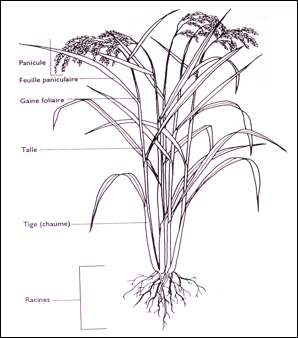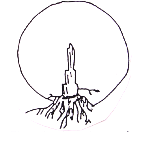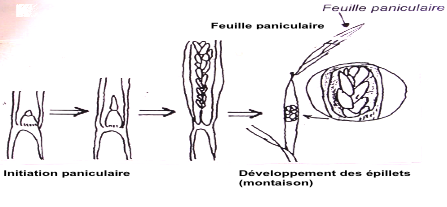Origin and taxonomy
Rice belongs to the family of Gramineae and the genera Oryzae. Oryzae contains about 20 different species, of which only two are cultivated: Oryza sativa L. (‘Asian rice’) and Oryza glaberrima Steud. (‘African rice’).

The species O. sativa, of Asian origin, comprises two main types: indica and japonica
The indica type from tropical Asia is usually characterized by:
· long, wide to narrow, light green leaves,
· profuse tillering,
· usually long and thin grains, and
· several secondary ramifications (small branches in the panicle holding the grains).
The japonica type, from temperate and subtropical Asia, is characterized by:
-
thin, light green leaves,
-
medium tillering,
-
short to intermediate size, and
-
rather short and round grains.


Oryza glaberrima originates from the inland delta of the Niger River. It is characterized and differentiated by the following characteristics:
-
profuse vegetative development—glabrous leaves and glumes (smooth, hairless), small and round ligules,
-
no or few secondary ramifications, red caryopsis (a grain with a red pericarp), long dormancy.
Nowadays, the Asian species (O. sativa) is cultivated far more than the African species (O. glaberrima), mainly because of its higher yield potential.
Structure of the plant
- The rice plant has round and hollow stems, flat leaves, and panicles at the top of the plant. Rice is a very flexible/adaptable plant that grows well under both flooded and rainfed conditions.
- The plant comprises vegetative organs: roots, stems, leaves, and reproductive organs; the latter is the panicle made up of spikelets.
Vegetative organs

Roots: The roots anchor the rice plant in the soil and absorb water and nutrients. Like other Gramineae, the root system of rice is relatively shallow, especially under flooded conditions (95% of the roots are found in the top 0 to 0.2 m of soil).
Stems: The stem is composed of a series of nodes and internodes. The internodes are hollow, with a smooth surface. The lower internodes are shorter than the upper ones. The shorter the lower internodes, the more resistant the plant will be to lodging. Each node has one leaf and one bud that can develop into a tiller. The stem’s main function is to transport water and nutrients and to bring air to the roots. The robustness (linked to their diameter) and height of stems are also criteria affecting resistance to lodging. From the nodes of the main stem, other stems, called secondary tillers, grow and can in turn produce tertiary tillers. The group of tillers produced by a single plant constitutes a rice hill. Tillering ability is a function of the variety, but is also influenced by growing conditions and crop management practices.
Leaves: The leaves grow alternately on the stem, with one leaf per node. The last leaf wrapping the panicle is called the panicle leaf or flag leaf. The leaves are the growth engine of the plant, as they capture solar radiation and produce carbohydrates. The plant breathes and perspires through its leaves. Leaf architecture may be erect, oblique or drooping; this depends on the variety and is an important factor in the ability to capture solar radiation.
The sheath is the leaf part that wraps the leaf. At the junction point between the leaf and the collar, two elements can be found: the auricle and the ligula.
The auricle is a 2 to 5 mm appendix, crescent-shaped and covered with hair.
The ligule is a membrane whose length and shape depend on species and variety; it is rather long in O. sativa, but short and round in O. glaberrima. Rice is the only Gramineae possessing both ligule and auricle, which allows distinction from weeds at the seedling stage.
Reproductive (flower) organs
Panicles: Panicles form the rice inflorescence. It is the top part of the rice plant, carried on the last inter-node. Panicles are composed of primary ramifications (small branches) that carry secondary branches themselves carrying the pedicels which carry the spikelets. The number of primary and secondary ramifications depends on species and variety. One single panicle can bear between 50 and 500 spikelets; however, in most cultivated varieties, their number reaches 150 to 350. There are variety differences in length, shape and angle of the panicles.

Flowers: The flower is composed of male reproductive organs (the anthers containing pollen) and the female organs (the ovary). Rice is self-fertile (autogamous) as fertilization occurs by the pollen of the same flower; this differs from allogamous plants where fertilization is by the pollen from another flower of the same or different plant, as is the case for maize.
Grain or paddy: The rice grain is composed of three main parts:
-
The rice envelope made of glumes (large portions above the pedicels that link the spikelets to the secondary ramifications) and the two husks called palea (upper husk with three /veins) and lemma (lower husk with 5 veins). The awns are the prolongation of the ventral vein of the lower husk. The husks, which wrap the rice grain (caryopsis), will constitute the chaff when husking.
-
The endosperm will feed the embryo during germination.
-
The embryo is situated in the ventral part of the spikelet.
Growth and development stages of rice

The rice cycle, whatever the variety and ecology, comes to an end after going through the following ten stages:
Germination (stage 0). The embryo will germinate as soon as it finds sufficient humidity (the equivalent of one-fourth of the grain weight) and a favorable temperature (optimum: 20° to 35°C). Germination marks the start of metabolic activity; emergence is when the coleoptile appears, from which will develop either the first leaf (under aerobic conditions) or the first radicle, i.e. the first root (under anaerobic conditions). The germination stage covers the period from the emergence of either the coleoptile or the radicle to the emergence of the first leaf.
Seedling (stage 1). This is the period (about 14 days) that follows germination, during which the young seedling essentially feeds on the food reserve in the endosperm. Leaf production follows a rhythm of one leaf every three to four days. The seedling stage covers the period from the emergence of the first leaf to the emergence of the fifth leaf. During this stage the seedling also produces roots. This stage is critical and the plant is very fragile.
Tillering (stage 2). This is the period during which the seedling produces tillers. This stage starts with the emergence of the fifth leaf. The number of tillers increases until maximum tillering. Thereafter, some tillers degenerate and the number of tillers stabilizes.
Germination (a), emergence (b), and tillering (c).

Inter-node elongation (stage 3). When the tillering stage comes to its end, the plant’s inter-nodes start to grow, leading to an increase in plant height.

Panicle initiation (PI) (stage 4). This stage is marked by the emergence of the panicle. The young panicle that emerges inside the bottom of the last node, is first a little feathery cone-shaped organ of 1–1.5 mm, which is only visible if the stem is dissected. In fact, the cone becomes visible only about 10 days after it is formed. At this stage, the number of grains in the panicle is already determined. In short-duration varieties, maximum tillering, inter-node elongation, and panicle initiation occur almost simultaneously. These stages occur in the above-mentioned order in medium to long-duration varieties. Timing of panicle initiation in rice is influenced by many factors, among which some constants are inherent to variety, temperature and photoperiod (see Reference 11). Panicle initiation is the beginning of the reproductive phase.

Panicle development (stage 5). This stage is characterized by the swelling of the bottom of the panicle leaf, which is due to the panicle growing upwards inside the stem. After initiation, the panicle grows towards the top of the stem, causing a swelling in the stem called elongation. The organs of the flower develop and the panicle grows on until it reaches its final size before appearing from the flag leaf (heading).

Heading and flowering (stage 6). Heading is characterized by the emergence of the panicle from the bottom of the panicle/flag leaf. The panicle takes two to three weeks to emerge from the stem completely. Three days after heading, flowering occurs and the process goes on progressively until the panicle has completely appeared. Flowering means that the flower opens and that pollination takes place. The opening occurs under the pressure of two transparent structures called lodicules, situated at the bottom and inside the grain, which dilate with warming, at the same time pushing apart the two husks ). In rice, this opening usually occurs between 9 and 11 a.m. As soon as the husks are open, the stamens stand up, and because of the outside temperature, the anthers dry out and liberate the pollen grains which then fall on to the stigmas first, then the pollen tube grows down to stigmata and the ovary, where fertilization takes place. Then the two husks come close together.
Milky stage (stage 7). After fertilization, the ovary swells and the caryopsis develops until it reaches its maximum size after seven days. The grain (caryopsis) is first aqueous and then reaches a milky consistency, which is perceptible when the grain is squeezed. At this stage, the panicles are still green and erect.
Dough stage (stage 8). The milky part of the grain becomes soft and then reaches a hard paste consistency about two weeks after flowering. The panicle begins to droop while the color of the grains, formerly green, progressively changes into the color that is characteristic of the variety (yellow, black, etc.).
Maturity (stage 9). The grain is ripe when it has reached its final size and maximum weight, giving the panicle its droopy appearance. Grains become hard and develop characteristic colors dependant on variety (yellow, black, etc.). This stage is reached when 85 to 90% of the panicle grains are ripe.
The development phases of the plant
The ten stages of rice development can be grouped in three larger phases:
- Vegetative phase covers the period from germination to panicle initiation,
- Reproductive phase covers the period from panicle initiation to flowering, and
- Maturity phase covers the period from flowering to complete maturity.

The vegetative phase: During the vegetative phase, the plant goes through the following stages of development: germination–emergence, seedling growth, tillering and inter-node elongation (according to variety). The duration of the vegetative phase varies according to variety, but it is also influenced by temperatures and the photoperiod (day-length), which may, when the variety is susceptible, lengthen the phase (see Reference 11). The relative length of the vegetative phase will determine whether the variety has a short, medium or long growing cycle. Most crop management operations have to take place during the vegetative phase, the most important being weed control (either by weeding or chemical herbicides), fertilizer application, insect and disease control.
The reproductive phase: This phase includes the following stages: panicle initiation, elongation and heading. It is characterized by the emergence of the panicle and by the development of the spikelets and reproductive organs. Its duration is relatively fixed—between 30 and 35 days—whatever the variety or season. The reproductive phase is not affected by photoperiod, but it is very susceptible to low temperatures, drought (water deficiency) and salinity, which can lead to sterility of the reproductive organs, which means the grains will be empty.
The maturity phase: This includes the following stages: flowering, milky and dough stages and maturity. Its duration is relatively fixed too—about 30 days—whatever the variety or season. It is susceptible to climatic hazards, such as, for instance, high temperatures, violent winds, and drought (water deficiency) during the first 15 days following flowering (dough stage). Draining the plots or stopping irrigation during the dough stage will not have negative consequences on production; it will, however, be beneficial to the rice plants as it will homogenize maturation and facilitate harvesting.
Extract from: PLAR-IRM Curriculum: Technical Manual (Wopereis et al., 2009).













